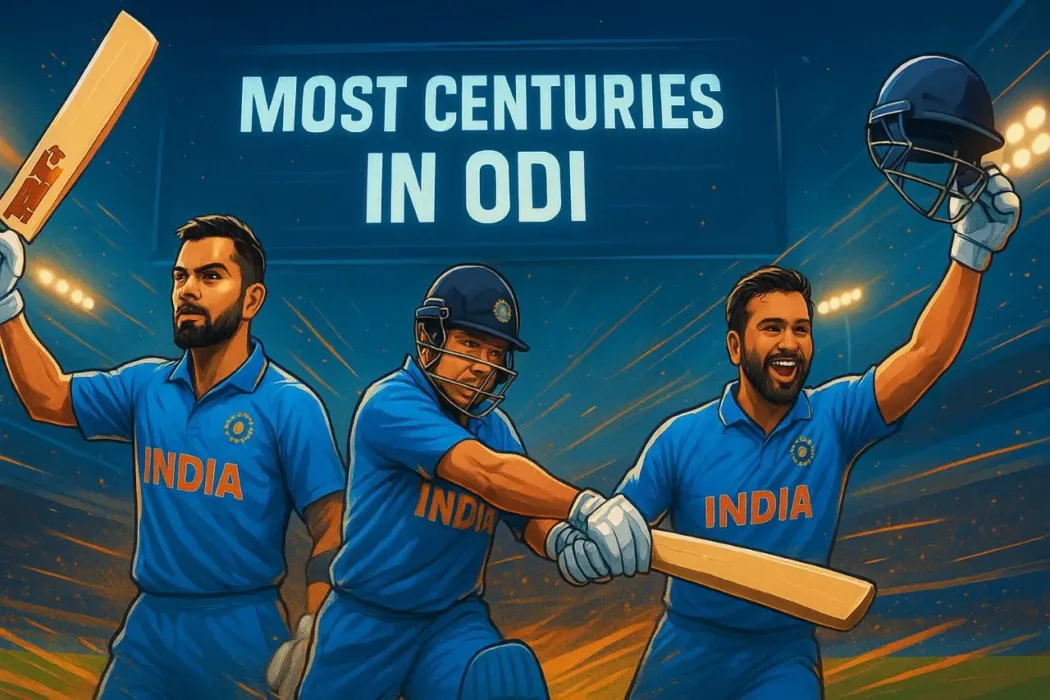One-day international cricket has always been about balance. Teams need both quick scoring and stability. In this format, centuries matter more than any other stat.
A batter reaching 100 not only boosts the team’s total but also shows remarkable control under pressure. Fans remember the great knocks for years to come. From World Cup classics to chasing hundreds under lights, these innings are timeless.
Table of Contents
Toggle
In this article, we focus on the most centuries in ODI and how the records look in 2025. We also compare the highest centuries in ODI by players and countries. This is not just a list of stats but also an insight into what makes these players special and why centuries define ODI cricket.
A century in ODIs reflects more than talent. It shows patience, fitness, and mental strength. Any batter can play a cameo of 30 or 40 runs, but building a hundred requires structure. The best batters learn to pace themselves, protect their wickets, and then explode later in the innings. That ability to “bat through” is rare.
Most ODI matches swing on the back of a single big innings. A century in the first innings often ensures a score above 300, which is a strong target. In run chases, centuries are priceless. Virat Kohli, for example, has won countless games for India while chasing. This shows that hundreds do not just look good in records—they directly change outcomes.
In earlier decades, ODI cricket was slower. A score of 250 was often match-winning. Today, teams expect 300–350 regularly. Batters are fitter, bats are better, and pitches are more batting-friendly. Powerplays and fielding restrictions also allow attacking play. The result is clear: the number of centuries has grown sharply over time, and they come at faster strike rates.
Rank | Player | Country | ODI Centuries |
1 | Virat Kohli | India | 51 |
2 | Sachin Tendulkar | India | 49 |
3 | Rohit Sharma | India | 32 |
4 | Ricky Ponting | Australia | 30 |
5 | Sanath Jayasuriya | Sri Lanka | 28 |
6 | Hashim Amla | South Africa | 27 |
7 | AB de Villiers | South Africa | 25 |
8 | Chris Gayle | West Indies | 25 |
9 | Kumar Sangakkara | Sri Lanka | 25 |
10 | David Warner | Australia | 22 |
Virat Kohli now stands at the very top with 51 centuries in ODIs. He crossed Sachin Tendulkar’s 49 during the 2023 World Cup and kept adding to his tally through 2024 and 2025. What separates Kohli from others is not just the number of centuries, but the circumstances in which he scores them. A large share of his hundreds have come in run chases, where the pressure is immense. His calm approach, ability to find gaps, and superb fitness allow him to rotate strike and then accelerate when needed. That makes him the most reliable batter in high-pressure situations.
Sachin Tendulkar was the first true giant of ODI batting. He finished with 49 centuries, a record that many thought would last forever. His role was tougher than modern openers face today. He played in an era with challenging pitches, less protective gear, and stronger bowling attacks. Despite that, he dominated with flawless technique. He also carried the hopes of a cricket-loving nation for over two decades. His centuries, whether in Sharjah, Australia, or at home in India, are still remembered as defining moments of the sport.
Rohit Sharma holds a unique place in ODI cricket. He has 32 hundreds, but his speciality is going beyond 100. He owns three ODI double centuries, an achievement unmatched by anyone else. His ability to convert starts into massive scores is his strength. When Rohit passes 50, bowlers know trouble is coming. His timing and effortless six-hitting make him one of the most dangerous ODI batters in history.
Ricky Ponting, with 30 centuries, led Australia’s golden era. He was not just a batsman but a leader who thrived in big matches. His ability to dominate fast bowlers and play aggressively in finals set him apart. Ponting’s hundreds came in an era where ODI pitches were tougher, which makes his record even more impressive.
Sanath Jayasuriya revolutionised opening with fearless hitting. Hashim Amla built his centuries with elegance and control. AB de Villiers redefined ODI batting with explosive strokes, while Kumar Sangakkara relied on consistency and placement. Chris Gayle’s power-hitting made him a unique entertainer, and David Warner’s aggressive approach gave Australia quick starts. Together, they form a remarkable group of century-makers who shaped modern ODI cricket.
India leads this area by a huge margin. With Kohli, Tendulkar, and Rohit, India’s top three alone have more than 130 hundreds. This dominance reflects not only individual brilliance but also the culture of batting depth in Indian cricket. Pitches in the subcontinent, strong domestic cricket, and an aggressive approach all help Indian batters turn starts into hundreds.
Sri Lanka’s golden period gave the world legends like Sangakkara and Jayasuriya. They carried the team for years with their runs. Pakistan has also produced many elegant batsmen, and Babar Azam is now carrying that legacy forward. His technique and patience make him a strong candidate for future century records.
Australia’s cricketing tradition is full of century-makers. Ponting and Warner lead the way, but others like Aaron Finch also played their part. South Africa saw two contrasting stars in Amla and de Villiers—one steady, one explosive. England, after revamping their ODI style post-2015, also saw more players hitting centuries regularly, thanks to their fearless approach.
Performing in ICC tournaments is never easy. The pitches are challenging, the pressure is high, and the world is watching. Rohit Sharma, with multiple World Cup centuries, has shown how to thrive under pressure. Kohli too has scored heavily in ICC events, including a memorable ton in the 2025 Champions Trophy.
This is where Virat Kohli stands apart. His record in chases is unmatched. He knows how to pace the innings, when to take singles, and when to attack. His chase-master reputation has been built on the back of these innings. Many of his 51 hundreds have come while guiding India to victory.
Some players hit form so strongly that they rack up centuries within one year. Sachin Tendulkar’s 1998 season remains iconic, with nine centuries in a single calendar year. More recently, Rohit Sharma and David Warner have also enjoyed dominant years with multiple hundreds. These purple patches show how confidence and rhythm matter in cricket.
Certain patterns emerge when you study the highest centuries in ODI history.
Batting positions matter: Openers and No. 3s dominate because they face the most balls.
Strike rotation is key: Players like Kohli and Amla are masters at turning singles into twos. That keeps the scoreboard ticking.
Venue advantage: Many centuries have come on subcontinent pitches, but legends like Sachin and Kohli have also scored hundreds abroad, proving their adaptability.
Tournament vs bilateral series: Hundreds in World Cups and ICC events carry extra weight because of the higher stakes.
The future looks bright. Shubman Gill of India is already showing signs of being a consistent century-maker. Pakistan’s Babar Azam continues to lead his side with elegance and calmness. Australia’s Travis Head has shown match-winning ability, and England’s new talents are also adapting quickly to the demands of modern ODI cricket.
The influence of T20 cricket cannot be ignored. Batters today accelerate faster and take more risks. This has led to quicker hundreds and higher totals. While strike rates have gone up, the challenge is to combine aggression with consistency.
Virat Kohli’s 51 hundreds will be extremely tough to beat. Modern schedules have fewer ODIs compared to the 1990s and 2000s. A player aiming to break his record will need a long career of 12–15 years at the highest level. While it is not impossible, it will take a rare talent and unmatched consistency to get there.
Centuries remain the heartbeat of ODI cricket. They inspire fans, lift teams, and create legends. As of 2025, Virat Kohli leads with 51 hundreds, followed by Sachin Tendulkar with 49, and Rohit Sharma with 32. These players have set a standard that future generations will chase.
The list of most centuries in ODI shows not just numbers but the story of dominance, patience, and class. The highest centuries in ODI are not just records—they are moments that shaped cricket history. The next decade will tell us who has the hunger and talent to join this elite list, but for now, Kohli, Sachin, and Rohit stand as the true giants of ODI batting.

I’m Avijit Brahma, a cricket enthusiast who enjoys dissecting games, evaluating player performances, and offering my opinions on the sport. I’m here to share my thoughts, ideas, and everything about cricket, whether it’s a thrilling finish or a knock that breaks records. Let’s have a proper conversation about cricket!